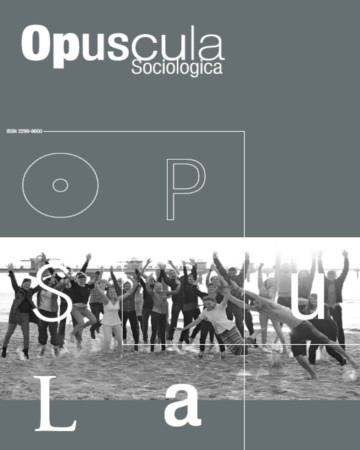
ISSN: 2299-9000
eISSN: 2353-2882
OAI
DOI: 10.18276/os.2018.1-01


Issue archive /
nr 1/2018
Rodzinna przestrzeń a technologie komunikacyjne
(Family Space versus ICT)
| Authors: |
Aldona
Żurek

Uniwersytet im. Adama Mickiewicza w Poznaniu |
| Keywords: | family family home communication technologies |
| Data publikacji całości: | 2018-11 |
| Page range: | 11 (5-15) |
Abstract
The family home, being a special space for the family, fulfls several important functions. First of all, it is a space where – in everyday interactions – the familiar bonds get stronger, thanks to which the family becomes a community. Members of a family more and more frequently use new ICTs (Information and Communication Technologies) and as a result the perception of the range of that space as well as how it is used have changed. There have appeared two parallel processes: the process of expanding that space and the one that makes it smaller. Both phenomena are connected with combining the virtual way of communication and the real-life one. An example of expanding the home space is the virtual presence of the family in the places other than their home. Narrowing that space may be exemplifed with virtual activities some members of the family do in the rooms the other members have no access to.
Download file
Article file
Bibliography
| 1. | Aarsand, A. (2007). Computer and Video Games in Family Life. The digital divide as a resource in intergenerational interactions. Childhood, 14, 235–256. |
| 2. | Beck, U., Beck–Gernsheim, E. (2013). Miłość na odległość. Warszawa: WN PWN. |
| 3. | Bielecka-Prus, J. (2014). Wycieczka po pokoju nastolatki: praktyki prezentacji przestrzeni prywatnej w wideoblogach. W: M. Łukasiuk, M. Jewdokimow (red.), Socjologia zamieszkiwania, (s. 121–154). Warszawa: WN Sub Lupa. |
| 4. | Castells, M. (2008). Społeczeństwo sieci. Warszawa: WN PWN. |
| 5. | CBOS (2017a). Korzystanie z internetu. Komunikat z badań, 49. |
| 6. | CBOS (2017b). Korzystanie z telefonów komórkowych. Komunikat z badań, 99. |
| 7. | Cherlin, A.J. (1992). Marriage, Divorce, Remarriage. Harvard: Harvard University Press. |
| 8. | Cherlin, A.J. (2004). The Deinstitutionalization of American Marriage. Journal of Marriage and Family, 66 (4), 848–861. |
| 9. | Douglas, M. (1991). The Idea of a Home: A Kind of Space. Social Research, 58 (1), 288–307. |
| 10. | Hałas, E. (2001). Symbole w interakcji. Warszawa: Ofcyna Naukowa. |
| 11. | EU-SILC (2015). European Union Statistics on Income and Living Conditions, c.europa.eu/eurostat/web/microdata (21.10.2017). |
| 12. | GUS (2015). Notatka informacyjna. |
| 13. | GUS (2017). Dochody i warunki życia ludności Polski. Raport z badań EU – SILC 2015. |
| 14. | Hampton, K. (2007). Neighborhoods in the Network Society: The e-Neighbors Study. Information, Communication & Society, 10 (5), 714–748. |
| 15. | Hampton, K., Oren L., Sessions Goulet, L. (2010). The Social Life of Wireless Urban Spaces: Internet Use, Social Networks, and the Public Realm. Journal of Communication, 60 (4), 701–722. |
| 16. | Hareven, T. (1991). The Home and the Family in Historical Perspective. Social Research, 58 (1), 253–285. |
| 17. | Jewdokimow, M. (2011). Zmiany społecznych praktyk zamieszkiwania. Warszawa: Wydawnictwo UKSW. |
| 18. | Ling, R., Yttri, B. (2006). Control, emancipation and status: The mobile telephone in the teen’s parental and peer group control relationships. W: R. Kraut, M. Brynin, S. Kiesler (red.), Computers, phones, and the internet: Domesticating information technology (s. 219–234). Oxford: Oxford University Press. |
| 19. | Mesch, G.S. (2006). Family Relations and the Internet: Exploring a Family Boundaries Approach. Journal of Family Communication, 6 (2), 119–138. |
| 20. | mobiRANK.pl (2017). Mobile i digital w Polsce i na świecie w 2016 roku. Pobrane z https://mobirank.pl/2017/01/24/mobile-digital-social-media (12.10.2017). |
| 21. | Morrison, M., Krugman, D.M. (2001). A Look At Mass and Computer Mediated Technologies: Understanding the Roles of Television and Computers in the Home. Journal of Broadcasting & Electronic Media, 45 (1), 135–161. |
| 22. | Nie, N.H. (2001). Sociability, interpersonal relations, and the Internet: Reconciling conflicting fndings. American Behavioral Scientist, 45 (3), 420–435.15 |
| 23. | Piotrowski, J. (1970). Współczesne gospodarstwo domowe i jego funkcje. W: Ekonomiczno-społeczna rola gospodarstwa domowego. Materiały z konferencji. Warszawa: CRZZ. |
| 24. | Postoła, A. (2017). Cyfrowi tubylcy nie istnieją, Gazeta Wyborcza, 10.10. |
| 25. | Prensky, M. (2001). Digital Natives Digital Immigrants. On the Horizon, 9 (5), 1–6. |
| 26. | Raport TNS (2015). Smartfonizacja w Polsce 2015. Pobrane z www.tnsglobal.pl/coslychac/fles/2015/05 (15.10.2017). |
| 27. | Rykwert, J. (1991). House and Home. Social Research, 58 (1), 51–62. |
| 28. | Szacki, J. (2002). Historia myśli socjologicznej. Warszawa: WN PWN. |
| 29. | Wajcman, J. (2008). Life in the fast lane? Towards a sociology of technology and time. The British Journal of Sociology, 59 (1), 53–77. |
| 30. | Wajcman, J., Bittman, M., Brown, J.E. (2008). Families without Borders: Mobile Phones, Connectedness and Work-Home Divisions. Sociology, 42 (4), 635–652. |
| 31. | Warren, C. (2010). Pride, Shame and Stigma in Private Spaces. Ethnography, 11 (5), 425–442. |
| 32. | Wellman, B., Haase, A.Q., Witte, J., Hampton, K. (2001). Does the Internet increase, decrease, or supplement social capital? Social networks, participation, and community commitment. American Behavioral Scientist, 45 (3), 436–455. |
| 33. | Woroniecka, G. (2014). „Ja” czy „my” w przestrzeni? Doświadczenia i klasyfkacje w sytuacjach współzamieszkiwania. W: M. Łukasiuk, M. Jewdokimow (red.), Socjologia zamieszkiwania (s. 35–62). Warszawa: WN Sub Lupa. |